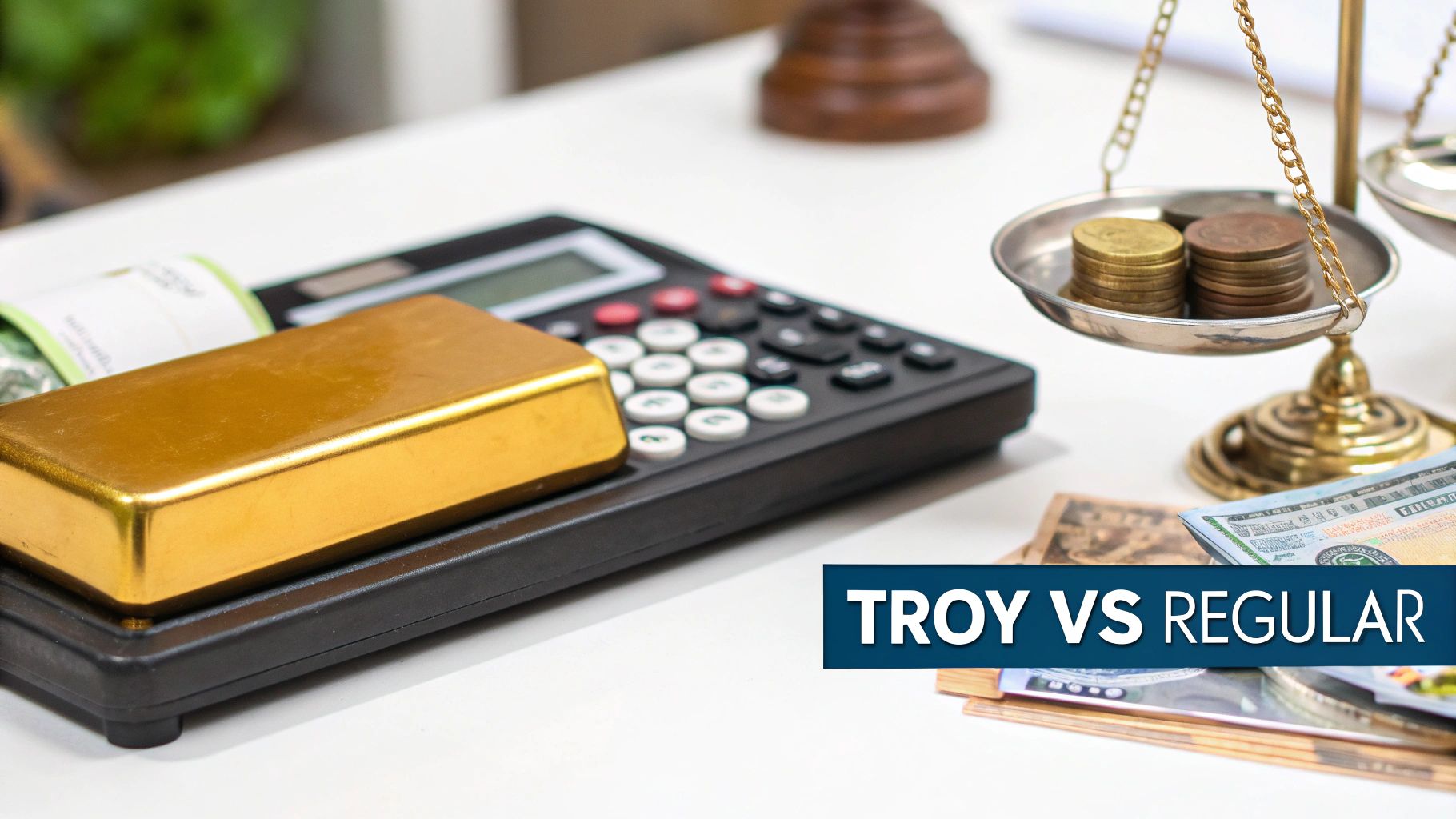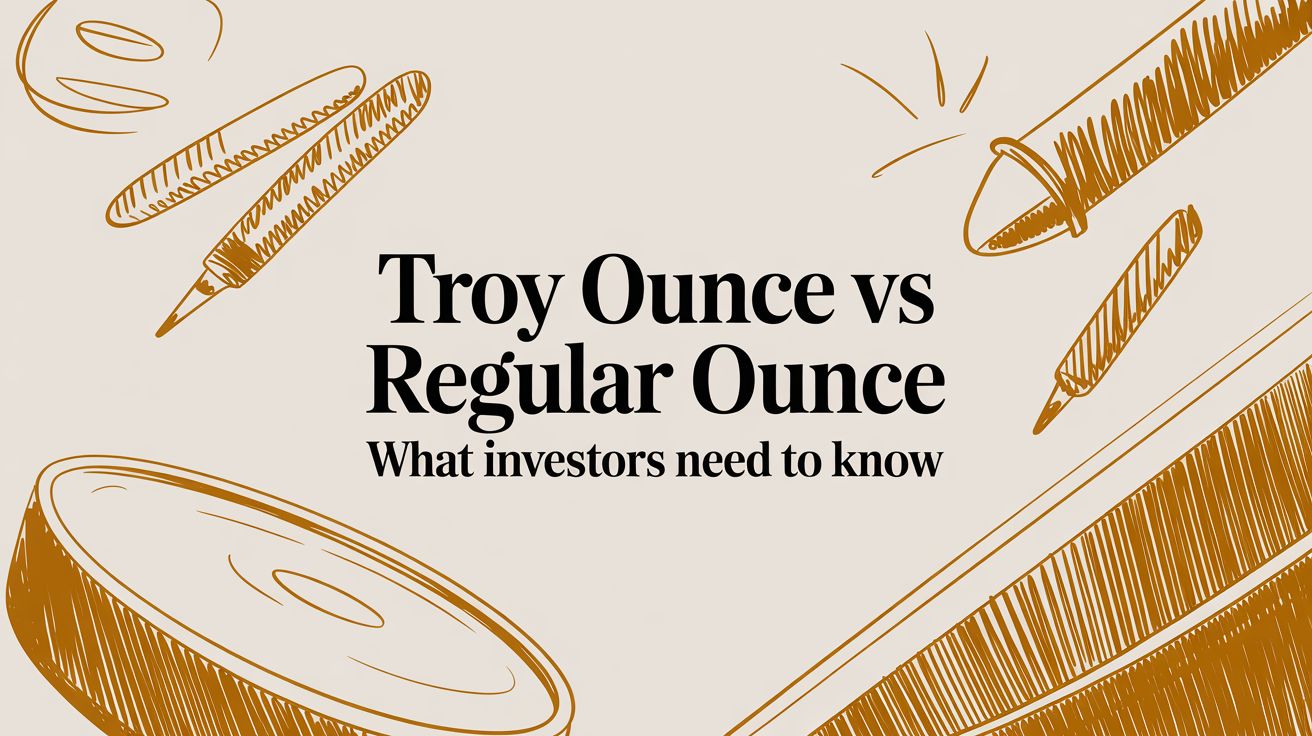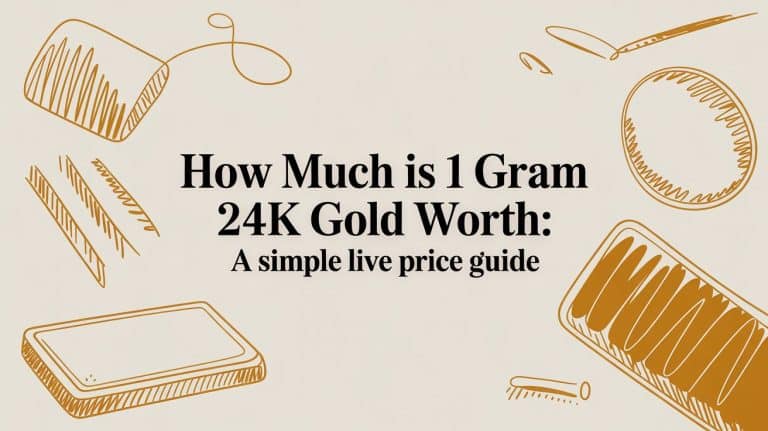Gold Troy Ounce vs Regular Ounce – What Investors Need to Know
When you are dealing with gold, you quickly learn that an ounce is not just an ounce. The difference between a troy ounce and the regular ounce you are familiar with from the grocery store is one of the most important things to get right. If you confuse them, you could make a very expensive mistake.
The Investor’s Quick Guide to Ounce Types
Let’s get straight to the point: a troy ounce is heavier than a regular, or avoirdupois, ounce. The regular ounce is for everyday items like coffee beans or produce. But when it comes to precious metals like gold, silver, and platinum, the troy ounce is the undisputed global standard.
The difference is not trivial. A troy ounce is about 10% heavier than a regular ounce, weighing 31.1 grams compared to the regular ounce’s 28.35 grams. That might not sound like much, but when gold is priced by the ounce, that 10% gap has a massive impact on the final price. For a deeper dive into how this affects trading, you can explore expert insights on precious metal measurements.
This infographic breaks down the weight difference visually.

As you can see, that 2.75 gram difference per ounce is precisely why the troy system is so crucial for maintaining a fair and consistent standard across the international precious metals market.
Troy Ounce vs Avoirdupois Ounce at a Glance
To make this crystal clear, here is a simple table that lays out the core differences. It is a handy reference for any investor trying to keep the two systems straight.
| Attribute | Troy Ounce | Avoirdupois (Regular) Ounce |
|---|---|---|
| Weight in Grams | 31.103 grams | 28.35 grams |
| Primary Use | Precious metals, gemstones | Everyday goods (food, produce) |
| Industry Standard | Global bullion and jewelry markets | Grocery and shipping industries |
Ultimately, knowing which “ounce” you are dealing with is fundamental. In the world of precious metals, you can safely assume any mention of an ounce refers to a troy ounce. In almost every other context, it is the lighter, regular ounce.
Tracing the Origins of Precious Metal Weights
Have you ever wondered why gold is weighed differently than, say, sugar or flour? It seems odd to have two kinds of ounces, but the reason is not some modern complication. It is a story that goes way back to the bustling trade routes of medieval Europe, where different goods demanded different standards.
The tale of the troy ounce begins in Troyes, a French city that was a major hub for international commerce in the Middle Ages. Merchants flocked there to trade high value items like silk, spices, and, most importantly, precious metals. When you are dealing with gold and silver, even a tiny miscalculation can be a costly mistake. They needed a system that was precise and universally trusted to keep things fair.
This demand for accuracy gave birth to the troy weight system. It was designed from the ground up for precision, making it the perfect standard for valuable metals where every fraction of a gram mattered.
The Rise of Two Competing Systems
While the merchants in Troyes were zeroing in on a system for treasure, another standard was taking hold for everything else. This was the avoirdupois system, a name that comes from the Old French phrase avoir de pois, meaning “goods of weight.”
The avoirdupois ounce, what we now just call a regular ounce, was created for bulkier, less expensive commodities. Think grain, wool, and other everyday staples. Since these goods were traded in huge quantities, a system built for volume was far more practical than the meticulous troy system. This practical split is why both systems have survived for centuries.
It really was not just about weight; it was about purpose. The troy system was built for precision and value. The avoirdupois system was built for volume and everyday commerce. This historical separation is exactly why they coexist today.
Solidifying a Global Standard
The influence of the troy ounce did not stay in France for long. England officially adopted it for its gold and silver currency way back in 1527. This was a huge moment that cemented the troy ounce as the benchmark for precious metals across the entire British Empire and, eventually, the world. To dig deeper into this history, you can check out this essential guide to the troy ounce.
Fast forward to today, and that legacy is still going strong. Every major international metals exchange, from the London Bullion Market Association (LBMA) to COMEX in New York, prices gold, silver, and platinum in troy ounces. It is an unbroken chain of trust. So when you buy or sell precious metals, you are using a measurement system that has been the gold standard, literally, for almost a thousand years.
A Detailed Comparison of Weight and Measurement
That 10% rule of thumb is a decent starting point, but in the world of gold, “close enough” can be a very expensive mistake. Precision is everything. Let’s dig into the exact numbers to see how a troy ounce vs. a regular ounce really stacks up and why this detail is non negotiable for anyone buying or selling precious metals.

It helps to remember that these two systems were built for completely different purposes. The troy ounce is a unit of mass specifically created for precious metals and gemstones. The avoirdupois ounce (what we call a “regular” ounce) is part of a much broader system used for, well, almost everything else you can think of.
The Numbers Don’t Lie
At the heart of the matter are the specific weights. A single troy ounce is exactly 31.103 grams.
On the other hand, a standard avoirdupois ounce weighs in at a lighter 28.35 grams.
That gives us a difference of 2.75 grams per ounce. It might not sound like much, but when you are dealing with an asset as valuable as gold, that tiny gap becomes a chasm. This is the core reason you simply cannot use a kitchen scale and expect an accurate valuation for your gold.
To see how this plays out in real transactions, especially when you are looking to sell jewelry or coins, it is critical to understand how weight and purity drive the final value. You can see a full breakdown in our guide on scrap gold prices.
How a Small Difference Becomes a Big Deal
The financial impact of that 2.75 gram gap compounds very quickly. Let’s say you have a 10 ounce gold bar. If you mistakenly weighed it using regular ounces instead of troy ounces, your calculation would be off by a staggering 27.5 grams.
When gold is priced at $2,000 per troy ounce, that 27.5 gram error translates to a financial blunder of nearly $1,800. This is not a rounding error, it is a significant loss caused by using the wrong unit of measurement.
To really hammer home how different these systems are, let’s compare a “pound” from each one.
| Unit of Measurement | Composition | Total Weight in Grams |
|---|---|---|
| Troy Pound | 12 troy ounces | 373.24 grams |
| Avoirdupois Pound | 16 avoirdupois ounces | 453.6 grams |
Isn’t that interesting? Even though a troy ounce is heavier than a regular ounce, a troy pound is significantly lighter than a standard pound. This counterintuitive fact highlights just how incompatible the two systems are. They must never be used interchangeably in precious metal transactions. Understanding this distinction is what protects you from costly mistakes and ensures every calculation is spot on.
How the Wrong Ounce Impacts Your Investment Value
This is where the distinction between a troy ounce and a regular ounce stops being a technical detail and starts hitting your wallet. Getting this wrong is one of the fastest ways to lose money when you are buying or selling precious metals. All official gold spot prices are quoted per troy ounce, making it the non negotiable industry standard.

Confusing the two can lead to a painful financial hit. If a buyer weighs your gold using a standard kitchen scale that measures in regular (avoirdupois) ounces, they could be shortchanging you by nearly 10%. On the flip side, if you buy gold priced per “ounce” without confirming it is a troy ounce, you might be overpaying for less metal than you think you are getting.
A Practical Example of Financial Loss
Let’s break down how this simple mistake translates into real dollars and cents.
Imagine you have a gold bar that weighs exactly 10 troy ounces. With the current spot price of gold at, say, $4,000 per troy ounce, the true market value of your bar is easy to figure out:
10 troy ounces x $4,000/troy ounce = $40,000
This is the number that matters. Now, let’s see what happens when the wrong scale enters the picture. An uninformed or dishonest buyer might weigh your bar using a regular ounce scale and then base their offer on that incorrect measurement.
To see the damage, we first need the price per gram.
$4,000 / 31.103 grams = $128.6 per gram.
Now, if someone treats your 10 troy ounce bar as if it were 10 regular ounces, their math would look like this:
10 regular ounces x 28.35 grams/ounce = 283.5 grams
Their Offer: 283.5 grams x $128.6/gram = $36,458
The difference between the correct and incorrect valuations is staggering.
By using the wrong unit of measurement, you would lose $3,541 on a single transaction. This is not a small rounding error; it is a significant financial loss caused by a fundamental misunderstanding of how precious metals are weighed.
Ensuring Accurate Gold Valuations
This example really drives home why precision is so critical. Every transaction, whether you are the buyer or the seller, must be based on the troy ounce standard. When you get a quote, always confirm the unit of weight being used.
Using a reliable tool is one of the best ways to protect your investment. A good gold calculator helps you to verify any offer and ensures you are getting fair value for your precious metals, every single time.
Avoiding Common and Costly Measurement Mistakes
When you are dealing with precious metals, knowledge is your best defense against expensive mistakes. One of the most common pitfalls investors stumble into is simply not understanding the difference between a troy ounce and a regular ounce. It sounds minor, but this one detail can lead to serious miscalculations and financial loss.

It all comes down to the classic riddle: “What weighs more, a pound of feathers or a pound of gold?” The surprising answer is the feathers. Why? Because feathers are weighed in standard (avoirdupois) pounds, which contain 16 ounces, while gold is weighed in troy pounds, which have only 12 troy ounces.
Why Your Kitchen Scale Is a Problem
This distinction is precisely why you cannot trust a standard kitchen or postal scale for weighing your gold. Those scales are designed to measure in regular ounces, which are nearly 10% lighter than troy ounces. If you use one, you will consistently undervalue your holdings.
To get a true weight, you absolutely must use a properly calibrated jeweler’s scale that measures in grams or troy ounces. If your scale only shows grams, that is perfectly fine, you can convert it. For example, our powerful scrap gold calculator lets you pop in the weight in grams and instantly see its value based on live market prices. This is a critical step for double checking any offer you get.
Always confirm the unit of measurement before you agree to a price. A simple question, “Is this price based on a troy ounce?” can save you from a major financial hit and ensure you are getting a fair valuation for your metal.
When you are looking at listings or talking to a potential buyer, you need to be proactive. Here are the essential questions to ask to make sure you are protected.
| Question Category | What to Ask | Why It Matters |
|---|---|---|
| Unit of Measurement | “Are you weighing this in troy ounces or grams?” | This confirms they are using the correct industry standard for precious metals. |
| Scale Calibration | “When was your scale last calibrated?” | An uncalibrated scale is useless. This ensures the equipment is accurate. |
| Purity Verification | “How are you testing the karat purity of the gold?” | This guarantees the valuation is based on the correct gold content, not a guess. |
A Few Final Questions for Investors
To round things out, let’s tackle a few common questions that always seem to pop up when people are first learning about the difference between a troy ounce and a regular ounce. Getting these details straight will give you a lot more confidence when you are buying or selling.
Why Do Jewelers Use Grams Instead of Troy Ounces?
You will notice that while the troy ounce is the king for pricing bulk precious metals, jewelers almost always work in grams. It is all about precision.
Most individual pieces of jewelry, like a ring or a delicate necklace, weigh far less than a full troy ounce. Quoting their weight in grams is just simpler and more practical than using tiny decimal fractions of an ounce. Think of it like measuring a pinch of salt with a teaspoon instead of a cup, it is just the right tool for the job. Both units are part of the same system, as one troy ounce is exactly 31.103 grams.
Are All Bullion Coins Weighed in Troy Ounces?
Yes, absolutely. The precious metal content of every major government minted bullion coin you will encounter, from the American Gold Eagle to the Canadian Maple Leaf, is measured in troy ounces. It is the global standard that keeps the market consistent and trustworthy.
However, here is a common point of confusion: a one ounce, 22 karat coin like the American Eagle will actually weigh a little more than one troy ounce on a scale. That is because it contains exactly one troy ounce of pure gold, plus a small amount of copper and silver alloys to make it more durable.
As a final tip, keep this simple conversion formula handy to check weights yourself: just multiply the number of avoirdupois ounces by 0.911 to find the equivalent in troy ounces. For example, if something is listed as five regular ounces, it is actually 4.555 troy ounces (5 x 0.911).
That quick piece of math is one of the best ways to verify weights and protect yourself from expensive measurement mistakes.
Ready to calculate the value of your gold with confidence? Use our free, real time gold calculator to get an accurate estimate based on live market prices.








